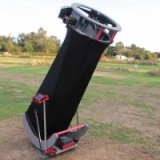Ok, ill try more with that input, sorry but Im a bit of work spare time now adays so its moving a bit slow.
×
INDI Library v2.0.7 is Released (01 Apr 2024)
Bi-monthly release with minor bug fixes and improvements
Driver for Raspberry Pi "High Quality Camera?"
- Keith Venables
-

- Offline
- New Member
-

- Posts: 12
- Thank you received: 1
Replied by Keith Venables on topic Driver for Raspberry Pi "High Quality Camera?"
Did you try the raspistill line I posted earlier?
For me, as written, the image is saved after about 1 second longer than the set exposure length. ie for a 5 second it takes 6.
If I remove the -bm, it gets a little longer.
if I remove -ex off, it does indeed get very much longer.
For me, as written, the image is saved after about 1 second longer than the set exposure length. ie for a 5 second it takes 6.
If I remove the -bm, it gets a little longer.
if I remove -ex off, it does indeed get very much longer.
3 years 3 months ago
#66460
The topic has been locked.
- Lars Berntzon
-

- Offline
- Senior Member
-

- Posts: 49
- Thank you received: 12
Replied by Lars Berntzon on topic Driver for Raspberry Pi "High Quality Camera?"
You mean this: raspistill -t 1 -md 3 -bm -ex off -ag 1 --shutter 200000 -ISO 800 -st -o /home/astroberry/Desktop/long.jpg
Its a 0.2 s exosure, I have not had problems with that before.
Its a 0.2 s exosure, I have not had problems with that before.
3 years 3 months ago
#66525
The topic has been locked.
- Keith Venables
-

- Offline
- New Member
-

- Posts: 12
- Thank you received: 1
Replied by Keith Venables on topic Driver for Raspberry Pi "High Quality Camera?"
sorry, I pasted a random line. I can adjust the --shutter right up to 10's of seconds.
That short exposure came from an experiment I did, changing the exposure length up in steps and looking at the histogram to make sure the actual image was getting stronger.
That short exposure came from an experiment I did, changing the exposure length up in steps and looking at the histogram to make sure the actual image was getting stronger.
The topic has been locked.
- Lars Berntzon
-

- Offline
- Senior Member
-

- Posts: 49
- Thank you received: 12
Replied by Lars Berntzon on topic Driver for Raspberry Pi "High Quality Camera?"
Just to make sure, when you say the image exposure does not change. You have turned of the stretch-button in the FITS-viewer then, otherwise the stretch function will normalize the exposure, with more or less noise as a side-effect.
3 years 2 months ago
#67040
The topic has been locked.
- Keith Venables
-

- Offline
- New Member
-

- Posts: 12
- Thank you received: 1
Replied by Keith Venables on topic Driver for Raspberry Pi "High Quality Camera?"
Yes - that can be a distraction!
I'm finding that if I start EKOS and go straight to the camera exposure tab, change gain first to anything 1 or higher, then change exposure to something long. It will give me a true long exposure straight away, and carry on doing so for the session.
Ive found you must not touch the exposure before the gain, as the moment exposure has been entered, a test image is captured automatically, which prevents future long exposures.
The command line I gave before still continues to be 'foolproof'.
I'm finding that if I start EKOS and go straight to the camera exposure tab, change gain first to anything 1 or higher, then change exposure to something long. It will give me a true long exposure straight away, and carry on doing so for the session.
Ive found you must not touch the exposure before the gain, as the moment exposure has been entered, a test image is captured automatically, which prevents future long exposures.
The command line I gave before still continues to be 'foolproof'.
3 years 2 months ago
#67041
The topic has been locked.
- Keith Venables
-

- Offline
- New Member
-

- Posts: 12
- Thank you received: 1
Replied by Keith Venables on topic Driver for Raspberry Pi "High Quality Camera?"
ps:
A load of messages I tried to post a month ago, suddenly appeared overnight.
A load of messages I tried to post a month ago, suddenly appeared overnight.
3 years 2 months ago
#67042
The topic has been locked.
Replied by Tino on topic Driver for Raspberry Pi "High Quality Camera?"
I wrote that weeks ago.
Tino
Tino
3 years 2 months ago
#67043
The topic has been locked.
- Lars Berntzon
-

- Offline
- Senior Member
-

- Posts: 49
- Thank you received: 12
Replied by Lars Berntzon on topic Driver for Raspberry Pi "High Quality Camera?"
Ok, ill try more with that input, sorry but Im a bit of work spare time now adays so its moving a bit slow.
The following user(s) said Thank You: Keith Venables
3 years 2 months ago
#67128
The topic has been locked.
- Keith Venables
-

- Offline
- New Member
-

- Posts: 12
- Thank you received: 1
Replied by Keith Venables on topic Driver for Raspberry Pi "High Quality Camera?"
Many thanks,
If there is anything I can do to help - tests, characterisation etc? Just ask.
Being retired I have no time excuses!
If there is anything I can do to help - tests, characterisation etc? Just ask.
Being retired I have no time excuses!
3 years 2 months ago
#67135
The topic has been locked.
- Gina Davis
-

- Offline
- Senior Member
-

- Posts: 63
- Thank you received: 7
Replied by Gina Davis on topic Driver for Raspberry Pi "High Quality Camera?"
Could I inquire as to the latest on this, please?
I have the Pi HQ Camera and want to try it in an All Sky Camera. Previously I have been using ZWO cameras for this with RPi 3B, in particular the ASI178MC but this is a relatively old camera and needs quite a lot of cooling (using 60s exposures) to reduce thermal noise and hot pixels. This system has worked well with KStars/Ekos/INDI but cooling has produced a complicated setup - cooling the case of a non-cooled astro camera is inefficient. I have friends who would like to make an ASC too but ZWO astro cameras are expensive and would be interested if I can get it working with a cheaper camera.
My thinking is that the Pi HQ Camera is a much later addition to the Sony sensor range and could well be a lot more advanced and more sensitive in spite of smaller pixels.
To summarise, I'm looking to use the Pi HQ Camera with INDI and RPi, maybe the RPi Zero, using exposures of around 30s to 60s.
Thanks in advance.
I have the Pi HQ Camera and want to try it in an All Sky Camera. Previously I have been using ZWO cameras for this with RPi 3B, in particular the ASI178MC but this is a relatively old camera and needs quite a lot of cooling (using 60s exposures) to reduce thermal noise and hot pixels. This system has worked well with KStars/Ekos/INDI but cooling has produced a complicated setup - cooling the case of a non-cooled astro camera is inefficient. I have friends who would like to make an ASC too but ZWO astro cameras are expensive and would be interested if I can get it working with a cheaper camera.
My thinking is that the Pi HQ Camera is a much later addition to the Sony sensor range and could well be a lot more advanced and more sensitive in spite of smaller pixels.
To summarise, I'm looking to use the Pi HQ Camera with INDI and RPi, maybe the RPi Zero, using exposures of around 30s to 60s.
Thanks in advance.
3 years 2 months ago
#67552
The topic has been locked.
- Keith Venables
-

- Offline
- New Member
-

- Posts: 12
- Thank you received: 1
Replied by Keith Venables on topic Driver for Raspberry Pi "High Quality Camera?"
Hi Gina,
Its quite useable with the current indi driver if ones takes care to set the parameters in the right order. I'm able to get exposures up to 200 sec, both through indi, and direct RPi command line.
However, I've been running it alongside a ZWOASI 120MM-S in a plate-solving project to compare performances. The small pixels do seem to be an issue. To get anywhere near the same sensitivity as the ZWO camera I have to bin it 4x4.
Its quite useable with the current indi driver if ones takes care to set the parameters in the right order. I'm able to get exposures up to 200 sec, both through indi, and direct RPi command line.
However, I've been running it alongside a ZWOASI 120MM-S in a plate-solving project to compare performances. The small pixels do seem to be an issue. To get anywhere near the same sensitivity as the ZWO camera I have to bin it 4x4.
The following user(s) said Thank You: Gina Davis
3 years 2 months ago
#67554
The topic has been locked.
Replied by Ben on topic Driver for Raspberry Pi "High Quality Camera?"
From what I can gather, it appears the RaspiHQ camera is perfectly usable within Ekos, as long as the correct setup order is done (Gain before exposure if I've read the thread correctly?). I've yet to test this in anger, but I appear to be getting some output during the day which is promising.
What I can't get to work though, is live video or video recording. The live video button below the sequence order window has a cross-through it?! Is this supported yet, or have I missed something on setup?
(Video seems to work fine via comman line and raspivid
What I can't get to work though, is live video or video recording. The live video button below the sequence order window has a cross-through it?! Is this supported yet, or have I missed something on setup?
(Video seems to work fine via comman line and raspivid
2 years 10 months ago
#72626
The topic has been locked.
Time to create page: 0.758 seconds
© 2003-2022 by INDI Library. All rights reserved.

